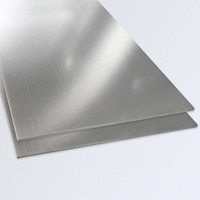| Items |

7075-T651-250-485-1445
Aluminum Plate - Series 7075-T651
|

7075-T651-313-485-1445
Aluminum Plate - Series 7075-T651
|

7075-T651-375-485-1445
Aluminum Plate - Series 7075-T651
|

7075-T651-500-485-1445
Aluminum Plate - Series 7075-T651
|

7075-T651-750-485-1445
Aluminum Plate - Series 7075-T651
|
|
Material
|
N/A
Aluminum
|
|
Shapeform
|
N/A
Plates
|
|
Series
|
N/A
7075-T651
|
|
Grade
|
N/A
7075
|
|
Preparation
|
N/A
Interleaved and Stenciled
|
|
Temper
|
N/A
T651
|
|
Finish
|
N/A
Mill
|
|
Thickness
|
N/A
0.25 inches6.3500 mm
|
N/A
0.313 inches7.9502 mm
|
N/A
0.375 inches9.5250 mm
|
N/A
0.500 inches12.7 mm
|
N/A
0.750 inches19.05 mm
|
|
Size
|
N/A
48.5 x 144.5
|
|
Width
|
N/A
48.5
|
|
Length
|
N/A
144.5
|
|
Sheet Weight per Unit Area
|
N/A
3.636 lbs/ft²17.750952 kg/m²
|
N/A
4.552 lbs/ft²22.222864 kg/m²
|
N/A
5.454 lbs/ft²26.626428 kg/m²
|
N/A
7.272 lbs/ft²35.501904 kg/m²
|
N/A
10.908 lbs/ft²53.252856 kg/m²
|
|
Weight per Plate
|
N/A
176.96 lbs80.16288 kg
|
N/A
221.55 lbs100.36215 kg
|
N/A
265.44 lbs120.24432 kg
|
N/A
353.92 lbs160.32576 kg
|
N/A
530.87 lbs240.48411 kg
|
|
ASTM Specification
|
N/A
AMS-QQ-A250/12 ASTM B209
|
|
Ultimate Strength
|
N/A
83 ksi
|
|
Yield Strength
|
N/A
73 ksi
|
|
Elongation percent in 2 inches
|
N/A
11
|
|
Hardness Brinnel Number
|
N/A
150
|
|
Ultimate Shearing Strength
|
N/A
48 ksi
|
|
Fatigue Endurance Limit1
|
N/A
23 ksi
|
|
Modulus of Elasticity2
|
N/A
10.4 x 102 ksi
|
|
Resistance to Corrosion - General3
|
N/A
C
|
|
Stress Corrosion Cracking4
|
N/A
C
|
|
Workability (Cold)5
|
N/A
D
|
|
Mechinability
|
N/A
B
|
|
Brazeability6
|
N/A
D
|
|
Gas Weldability7
|
N/A
D
|
|
Arc Weldability8
|
N/A
D
|
|
Resistance Spot and Seam Weldability9
|
N/A
B
|
|
Applications
|
N/A
Aircraft and other structures
|
|
Density
|
N/A
0.101 lbs/in³
|
|
Specific Gravity
|
N/A
2.81
|


